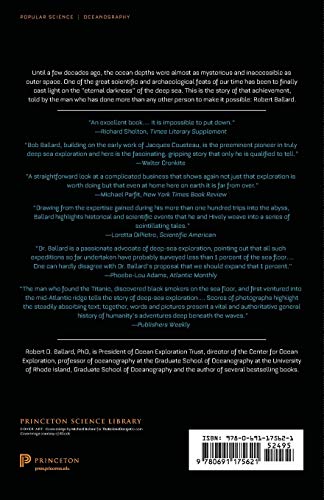


The Eternal Darkness: A Personal History of Deep-Sea Exploration (Princeton Science Library): 50
A**E
Adventure in the ocean deeps
Of the volume available on our planet, about 1% is occupied by land life. A further 2-3% is represented by the upper layer of the oceans, to a depth that can be penetrated by light. This is the region of algae, seaweed, coral reefs and the fish that live on them, a region we are familiar with through numerous films and television documentaries. Beyond the reach of sunlight is the realm of total darkness, which comprises the remaining 97%. We know more about the moon’s surface and some of the planets than we know about this realm.Robert Ballard is perhaps best known for his finding of the resting place of the Titanic. The technology that led to this success came after many decades of development, beginning with quite heroic explorations during the 1930s, in vessels that were little more than steel balls into which the adventurers were squeezed in the knowledge that they might not return.This book is very much a personal account of the endeavours of its author, but he gives due credit to the pioneers who inspired him. In the first of the book’s three sections, he tells of these early expeditions, when the goal was primarily to reach a depth that broke records set by one’s competitors. These culminated in a descent to the Challenger Deep, in the Marianas Trench in 1960, a feat that has not been repeated. The US military realised the potential of deep sea exploration when it lost a submarine in 1963 and a nuclear bomb three years later.Having overcome the major barriers, the era of scientific research could begin, facilitated by the use of free-diving submersibles. This led to the discoveries of the mid-ocean ridge, which confirmed the theory of plate tectonics, and the hydrothermal vents and black smokers that harbour exotic life that does not depend on photosynthesis. The implications for the origins of life on Earth are profound, while the potential for finding it on other planets has not gone un-noticed by NASA.The final section deals with the use of unmanned submersibles in the archaeology of the deep seas, beginning with the Titanic expedition and going on to the search for ancient wrecks in the waters of the Mediterranean. In parallel with recent developments in space exploration, these vessels can now be fully controlled by scientists working in their laboratories on land, something about which the author is enthusiastic.This is a well-told story of an exciting adventure that has just begun, with many more as yet unimagined discoveries still to be made.
C**Y
Supurb
What a read, slightly one sided but then it is a personal history. Gives a very clear and excellent review of historical items to do with underwater exploration. Super read and could not put it down for 11 days.Excellent!!
Trustpilot
2 weeks ago
3 weeks ago